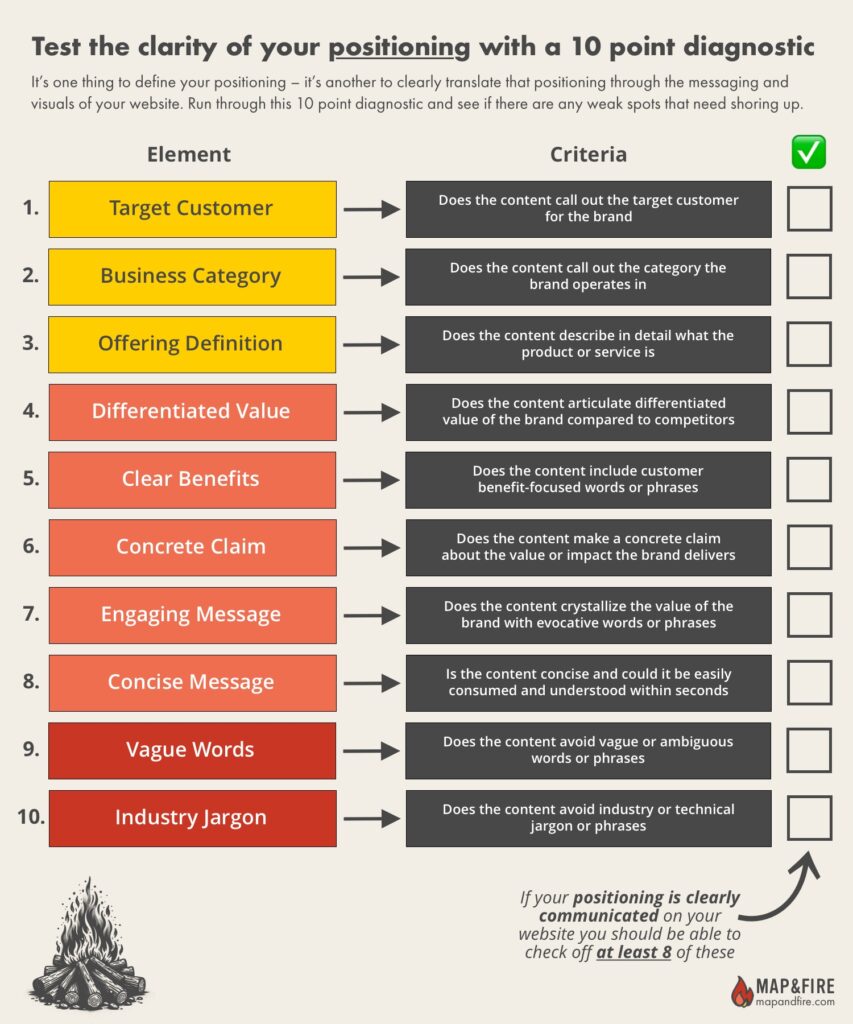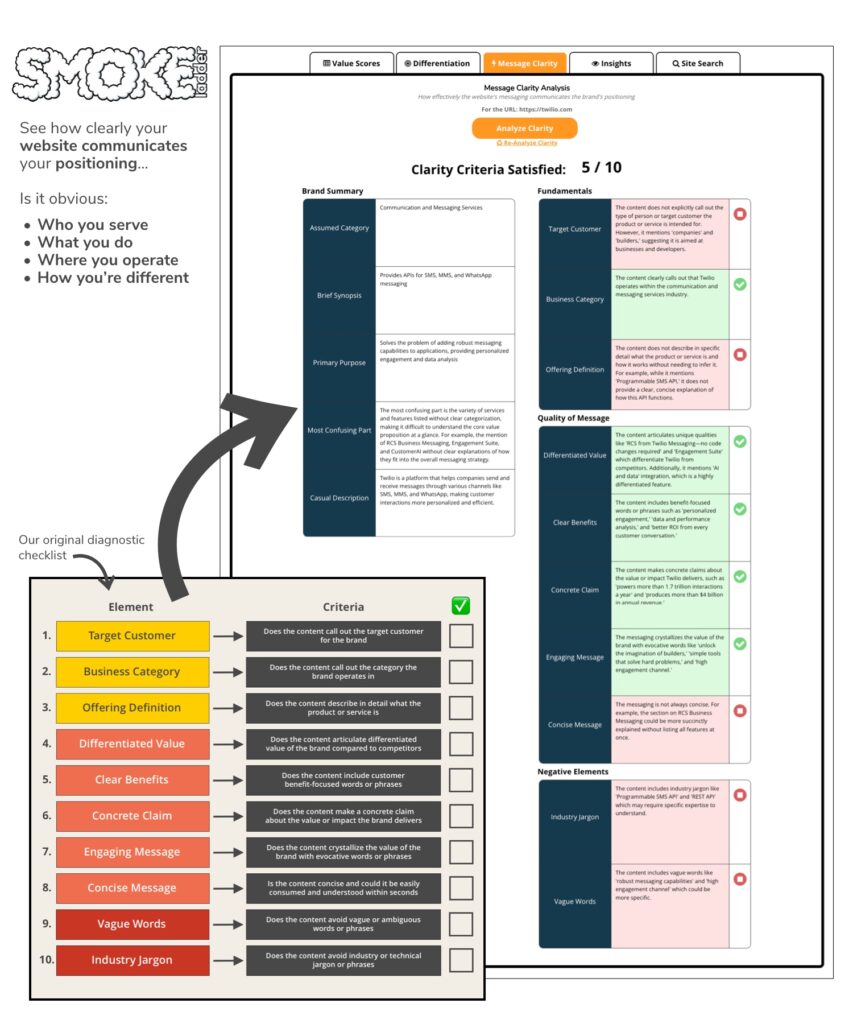
Creating truly differentiated positioning for your brand isn’t easy.
It requires a deep understanding of your customers and competitive market, and then aligning that with the unique strengths of your products, services, and operations.
If you don’t take the time to conduct research and use a strong strategic process you can easily end up with surface level, default ideas that blend into the noise.
Once you go through that gauntlet and get your positioning nailed down it can feel like the hard part is done.
But there’s one more big step needed to make the process a success.
Communicate it clearly.
After spending days, weeks, or even months (hopefully not that long!) immersed in positioning work it’s easy to take for granted the clarity of it.
Unfortunately your customers aren’t privy to all the work you did.
All they get is what’s in front of them.
They land on your website and consume your content with fresh eyes.
It’s up to you to ensure that the most critical points of your positioning actually shine through.
To do this effectively it requires a mix of delivery elements:
- Functional: do you articulate the nuts and bolts of your positioning?
- Emotional: do you present it in an engaging and evocative way?
- Stylistic: do you use language that makes it easy to understand the message?
When you don’t nail these elements all of that hard work can easily go out the window.
Customers won’t absorb, remember, and get excited about what makes your offering unique.
They won’t build trust with your brand.
They certainly won’t take out their wallet to make a purchase.
To help solve that here are 10 points to ensure your positioning crosses the bridge from strategic-concept to communicated-reality.
Here’s an overview of the 10 point diagnostic – you can download this as a PDF here.
This diagnostic is designed to evaluate your website but you could also use it to breakdown key pieces of content, ad campaigns, or your sales pitch
Any place you communicate with your customers is a place to ensure your positioning comes through clearly.
How to check your positioning’s clarity
Here are each of the 10 criteria to consider to make sure your positioning gets communicated clearly and effectively:
(1) Target Customer
Type: Functional
Key Question: Does the content call out the target customer for the brand?
Why it’s critical: Everything you do as a brand starts with your customers. To build a connection with customers and help them self-qualify for your offer, call out who you serve by name. This reinforces the specificity of your offer and helps you avoid wasted time with bad-fit, underqualified prospects.
(2) Business Category
Type: Functional
Key Question: Does the content call out the category the brand operates within?
Why it’s critical: Customers need context to help understand where a brand fits in their life – or whether it fits at all. When you specify the category you operate in, it allows customers to associate your product or service with the correct needs and helps set the table for what a standard solution is and makes you different.
(3) Offering Definition
Type: Functional
Key Question: Does the content describe in detail what the product or service is?
Why it’s critical: Product and service benefits are important but it can’t come at the cost of actually explaining what the offer does and how it works. This is an easy piece to underdeliver on because you live and breathe your offering and may think it’s obvious how it works – but for new customers it definitely isn’t. Tell them and show them exactly what it does.
(4) Differentiated Value
Type: Emotional
Key Question: Does the content articulate differentiated value of the brand compared to competitors?
Why it’s critical: This comes in the 4th slot but in many ways it’s number one. If you want to capture your customer’s attention and occupy a unique place in their brain you have to convey what separates your product or service from all the other options they may consider. Think about it this way – if there was one word or phrase that sets your brand apart and that you’d want your customers to associate with your value, what would that be? Make sure that shines through.
(5) Clear Benefits
Type: Emotional
Key Question: Does the content include customer benefit-focused words or phrases?
Why it’s critical: The flip side of your offering description is what value it delivers to your customers. How will their lives be better as a result of engaging with your product or service? Don’t make them do the heavy mental lifting, spell it out for them in clear detail.
(6) Concrete Claim
Type: Emotional
Key Question: Does the content make a concrete claim about the value or impact the brand delivers?
Why it’s critical: Nothing brings a product or service to life and helps it stick in a person’s mind like specific data and details. This helps move the value you provide from hypothetical to something concrete they can imagine. Just be sure any claims are grounded in reality – customers can see right through inflated, best-case-scenario statistics.
(7) Engaging Message
Type: Emotional
Key Question: Does the content crystallize the value of the brand with evocative words or phrases?
Why it’s critical: Engaging and evocative language serves a real strategic purpose. If you trigger an emotional response in your customer it will help the message stick in their minds more deeply. Breaking up dry descriptions with unusual or powerful words helps shake the reader out of their zombie-scroll and pay attention.
(8) Concise Message
Type: Emotional
Key Question: Is the content concise and could it be easily consumed and understood within seconds?
Why it’s critical: There’s a lot of information to convey to your customers but time is of the essence. You may only have a new prospect’s attention for a handful of seconds before they decide to stick around or bolt. Keep your communication lean and focused on the most critical points.
(9) Vague Words
Type: Stylistic
Key Question: Does the content avoid vague or ambiguous words or phrases?
Why it’s critical: When you speak in general or vague terms the message doesn’t stick. Your goal is to paint an exact picture of what makes your product or service uniquely valuable and how your customer’s life will change as a result of using it. Broad strokes make for dull imagery.
(10) Industry Jargon
Type: Stylistic
Key Question: Does the content avoid industry or technical jargon or phrases?
Why it’s critical: Even smart customers with industry knowledge have to work harder to read and comprehend content that’s full of abbreviations and industry terms. And for those that don’t know all your terms (think about the CFO who needs to approve the purchase) they may get totally lost. In an effort to look smart you may alienate folks.
Total up your clarity score
If your positioning is communicated clearly you should be able to check off at least 8 out of 10 of these points. Anything lower and you likely have real gaps that need to be addressed.
Of course the points are not all created equal.
As mentioned above, points like (3) Offering Definition and (4) Differentiated Value hold extra weight if you want your customer to understand and remember what you do.
The bottom line is, your positioning is only as effective as your ability to communicate it clearly.
Customers don’t have access to all the meetings and discussions you have with your team. All they get is what’s in front of them.
Make sure what you present puts your brand in the best, most unignorable light possible.
Bonus! Use our app SmokeLadder to run a clarity analysis
Our app SmokeLadder allows you to instantly analyze the positioning of your brand or your competitors. This helps you see your strengths, weaknesses, and biggest points of differentiation.
SmokeLadder’s latest update is the Message Clarity feature.
This allows you to run the diagnostic outlined above on any website to see how many of the 10 points it delivers on.

Get Help Clarifying Your Positioning
If you’re ready to build stronger connections with your customers, reach out for a free consultation. We’ll help you transform your best business thinking into an actionable, shareable, growth-oriented guide. Click below to learn more about the Brand Guidebook process.



